how to find p value in excel
InvestorPlace - Stock Market News, Stock Advice & Trading Tips
Stock market news and analysis is dominated by coverage of the S&P 500 Index. That index is dominated by technology, with sector stocks making up 28.10% of the weighting of the index. And much has been made of the index now returning 8.46% for the year to date — astonishing given the wider market plunge earlier this year and the continued decimating effects of the COVID-19 pandemic.
But the S&P 500 alone can't tell the full story of the U.S. stock market. If we consider an equal weighted S&P 500 Index, return is actually down, for negative 1.51% for the year to date.
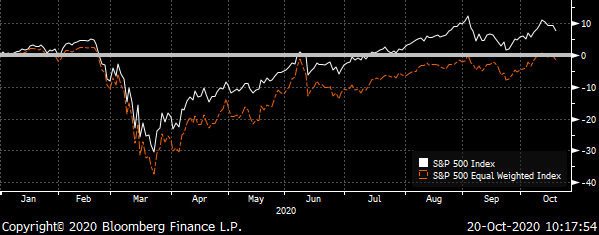
Source: S&P 500 & Unweighted S&P 500 Indexes Total Return – Source: Bloomberg
And while the focus on technology as resilient to the impacts of COVID19 is a compelling story, it is not without some road bumps in the stock market. Take September's big drop, when the S&P 500 dropped by 9.60% and the S&P Technology Index by 12.84%.
I argue that while technology companies have a lot going for them, their stocks have gotten very, very expensive.
Elevated Valuations Look Precarious
The S&P 500 Index's price to earnings ratio has soared to 26.63, which is exceedingly high.
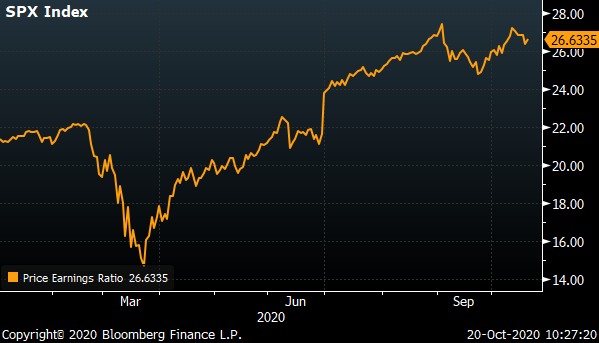
Source: S&P 500 Index Price to Earnings Ratio – Source: Bloomberg
And the S&P Information Technology Index's price to earnings ratio is even higher up in the stratosphere, at 33.47.
Now, stock markets are forward looking. Bloomberg compiled expectations for tech stocks in 2021 show 10.45% growth and 13.52% growth year over year for Q1 and Q2 respectively. So there is some cover for the argument to buy. But even with these expectations, stocks are still at very expensive levels.
But there is a market sector inside the S&P 500 that is still a value buy — and has been quietly outperforming both the S&P 500 Index overall and more impressively, the technology sector since September 2.
Utility Players
Utilities are some of the least exciting stocks when it comes to the news. But these are the companies that keep power flowing for all of the electronics, electric cars, data centers, cloud computing operations and other companies one would consider media darlings.
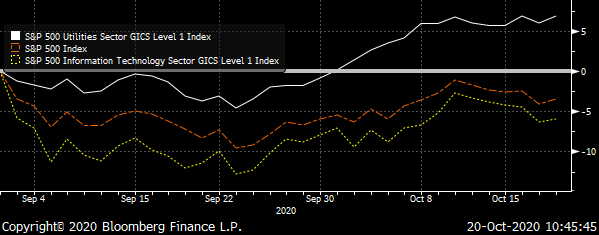
Source: S&P Utilities, S&P 500 & S&P Information Technology Indexes Total Return – Source: Bloomberg
Bloomberg
Utility stocks inside the S&P have returned 6.88% from September 2 to date, compared to the price drop in the S&P 500 by 3.63% and Information Technology Index by 6.03% over the same timeframe.
And utility stocks are a lot less pricey at a price to earnings ratio of 17.72, which is elevated year to date, but not by much. And it is still very much at a discount compared to prices back in the fall of 2019.
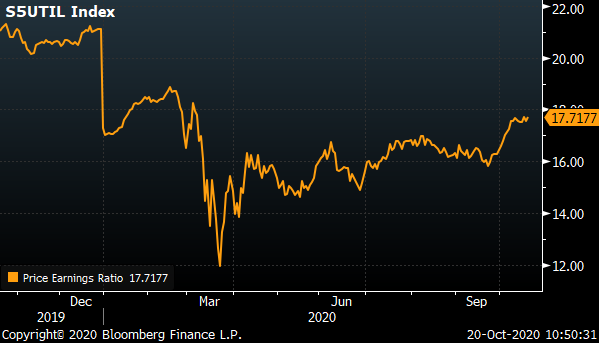
Source: S&P Utilities Price to Earnings Ratio – Source: Bloomberg
On a price to sales basis, utilities look way cheaper, at just 2.87 times. And things get even better on a price to book basis, at only 2.25 times.
Moreover, when looking at market price volatility of utilities against the S&P 500 — the dependable value stocks are currently running at only 16.04% on a trailing 30 day basis compared to the S&P 500 running at 19.02% and 26.22% for the Information Technology Index.
So, cheaper values, less volatility in a highly charged and unsettled general stock market make utilities all the more attractive.
And that's before I get to the dividend yield advantage that utilities have over both the S&P 500 and the S&P Information Technology stocks.
The S&P 500 has a trailing yield of 1.74% and the S&P Information Technology has a yield of 1.10%. But the S&P Utilities Index has a yield of 3.21%. And there are many utilities that beat that yield that are inside the model portfolio of Profitable Investing.
5 Stocks That Beat the S&P 500: NextEra Energy (NEE)
And it's not that you sacrifice great longer-term returns by having utilities inside your own portfolio. Take NextEra Energy (NYSE: NEE ) — it has returned 676.27% since being added to the model portfolio many years ago. This is leagues ahead of the return of the S&P 500 Index for the same time period.
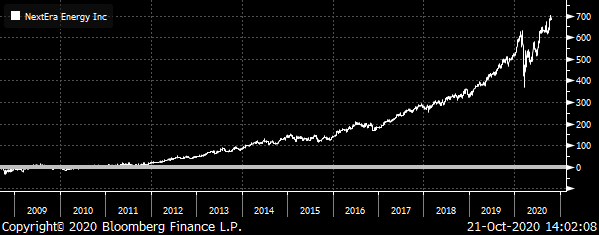
Source: NextEra Energy (NEE) Total Return – Source: Bloomberg
NextEra has the regulated base operations of power for Florida — but has expanded to the rest of the nation as the largest capacity company for wind and solar power.
Dominion Energy (D)
Dominion Energy (NYSE: D ) has returned 338.99% since being added to the model portfolio. This again successfully rivals the S&P 500 Index.
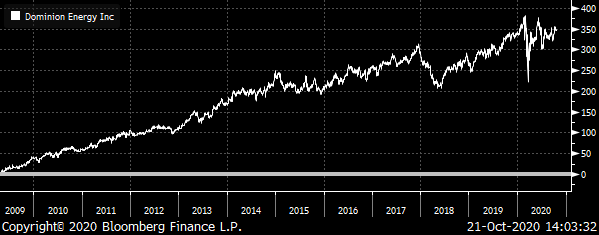
Source: Dominion Energy (D) Total Return – Source: Bloomberg
Dominion is a major provider of power and other essential services to core states in the Mid-Atlantic and Southern US states. And it continues to ramp up ESG-friendly green energy including the largest off-shore wind turbines in Virginia waters.
Public Service Enterprise Group (PEG)
Public Service Enterprise Group (NYSE: PEG ) has returned 191.37% since it was added to the model portfolio, once again proving that utility companies can be high return stocks.
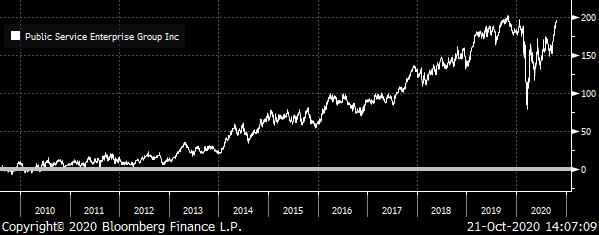
Source: Public Service Enterprise Group (PEG) Total Return – Source: Bloomberg
Public Service Enterprise Group has its core operations in power and natural gas services to the Northeastern and Mid-Atlantic markets of the US. And like the other high-performing utilities, Public Service has reliable core regulated businesses with the addition of higher-growth unregulated power generation operations.
Excel Energy (XEL)
Even more recent additions to the portfolio are doing exceedingly well. Excel Energy (NYSE: XEL ) has returned 51.22% since late 2018 which is way ahead of the S&P 500's return of 33.65%.
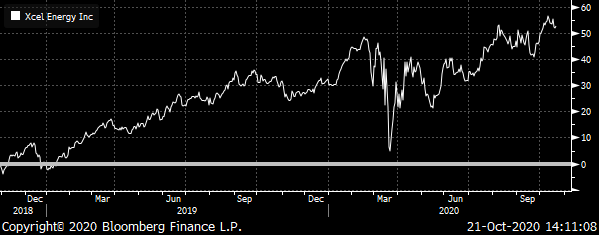
Source: Excel Energy (XEL) Total Return – Source: Bloomberg
Excel Energy is comprised of four core regulated power and natural gas businesses in the Northern Central, Western and Southwestern U.S. states. And like for NextEra, it has the playbook of rolling out a big expansion of ESG green power capabilities making for a junior version of the Florida-based company that's also a bit on the cheap in value in its stock.
Eversource Energy (ES)
Last up is Eversource Energy (NYSE: ES ), which was added at the same time to the model portfolio as Excel and has returned 52.30%. since then, also beating the general stock market.
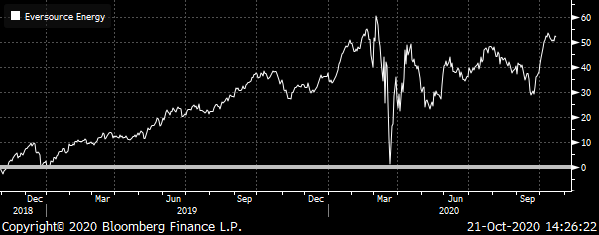
Source: Eversource Energy (ES) Total Return – Source: Bloomberg
Eversource Energy is right in the heart of New England and through the hot summers and bitter cold winters, the company is there to provide and sell plenty of power and natural gas. And it also has a nice water company that generates a nice return to shareholders as well.
Value doesn't mean lack of performance. It just means that you can buy and own now cheaper stocks in the market with more dependability — especially as we head through the U.S. elections, year-end turbulence and — oh yeah, the ongoing pandemic.
On the date of publication, Neil George did not hold (either directly or indirectly) any positions in the securities mentioned in this article.
As the editor of Profitable Investing, Neil George helps longer-term investors achieve their growth & income goals with less risk. With 30+ years of experience in the financial markets, Neil recommends undiscovered and underappreciated companies that offer subscribers double-digit yields now and triple-digit returns over time.
More From InvestorPlace
- Why Everyone Is Investing in 5G All WRONG
- Top Stock Picker Reveals His Next 1,000% Winner
- Radical New Battery Could Dismantle Oil Markets
- Revolutionary Tech Behind 5G Rollout Is Being Pioneered By This 1 Company
The post 5 Value Stocks To Buy Now Beating The S&P 500 In 2020 appeared first on InvestorPlace.
how to find p value in excel
Source: https://markets.businessinsider.com/news/stocks/5-value-stocks-to-buy-now-beating-the-sp-500-in-2020-1029712423
Posted by: tatummuccer.blogspot.com

0 Response to "how to find p value in excel"
Post a Comment